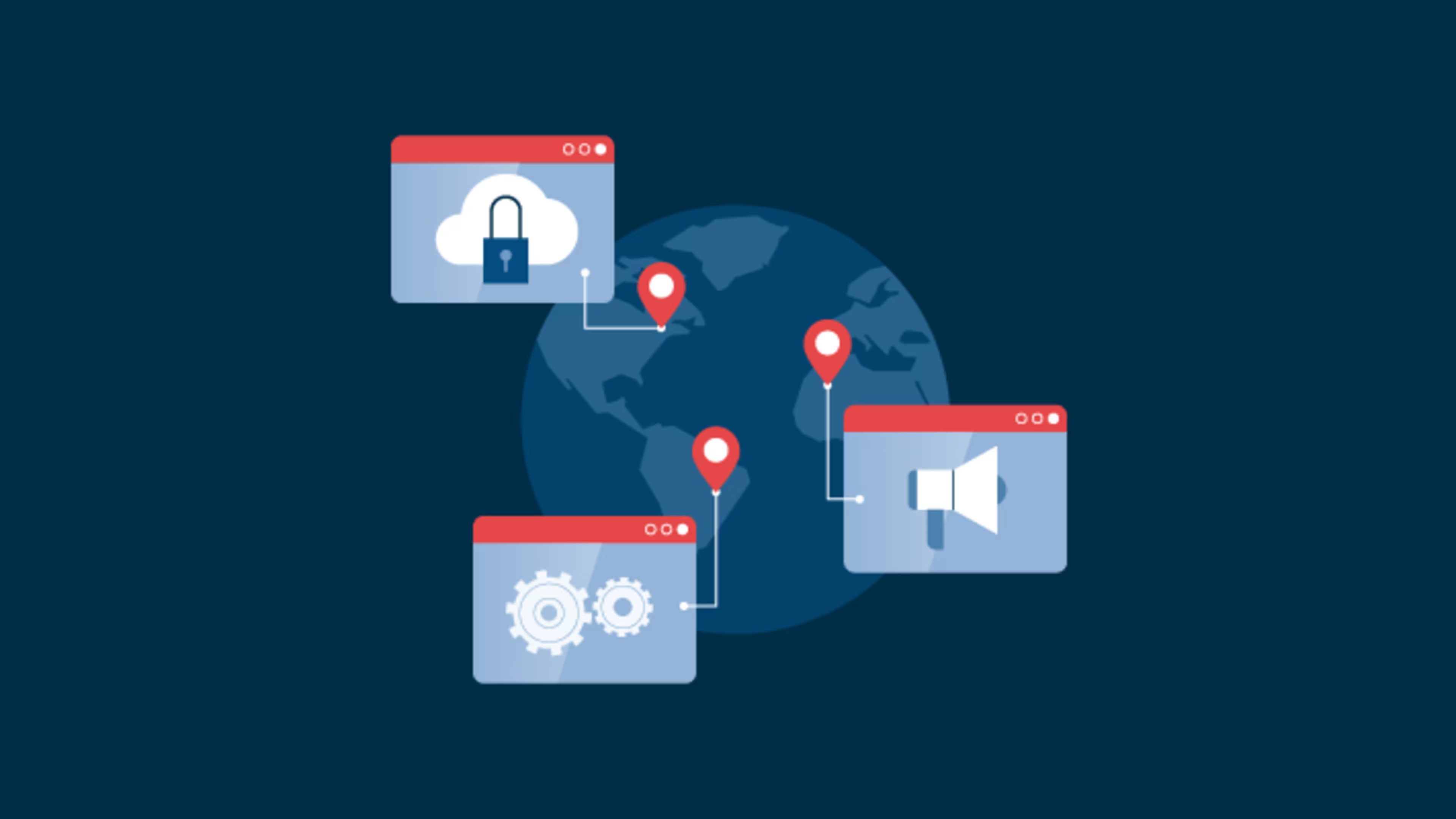Business-service purchasers spend nearly 74K a project. Learn how to maximize your business services investment.
Macroeconomic forces and hiring shortages continue to pose challenges for small to midsize businesses (SMBs) and many companies are turning to service providers to fill those staffing gaps.
Businesses are using strategic, outside partners for common services such as marketing, accounting, and web design. Business service providers are also tapped to produce high-quality deliverables when overstretched teams can't complete the work themselves. In fact, 44% utilize service providers because they don’t have the bandwidth—even though they have the expertise in-house.*
But it can be difficult to evaluate and manage external providers. If not done properly, going outside of your organization might be more costly in the long run or leave you dissatisfied with the results. If you are considering strategic partners, it’s essential to know which qualities to look for and how to budget your time and money.
To learn first-hand how SMBs are using, evaluating, and investing in external partners, Capterra surveyed 1,078 U.S. past services purchasers (those who have purchased or commissioned a service in the last 18 months). Continue reading to help your organization effectively navigate and plan for future business service investments.
/ Key findings
Bandwidth is the biggest driver for business service buyers: 44% of SMBs use service providers to overcome bandwidth challenges—even when they have the expertise.
Agility is a must-have: Business-service purchasers look for providers they see as creative and flexible (31%). These considerations are ranked more important than cost (28%) and geography (27%).
The average business-service purchase is substantial: The average amount service purchasers spend on a single project is more than $73,000.
Marketing services have the highest single project cost: Buyers spent $78,700 on average.
For longer-term engagements, software/web development and cloud consulting services were the priciest: Over 18 months, service buyers spent $121,600 on software/web development services and and $117,900 on cloud consulting services.
Lack of bandwidth is a top trigger for utilizing business services
Even when you have an expertly skilled staff, sometimes it makes sense to bring in extra help from an outside source. Our survey finds that across industries, a lack of bandwidth (not a lack of expertise), is the primary trigger for an SMB to start searching for a business-services provider.
While most people will experience heavy workloads at some point, we find that industries with fluctuating or seasonally dependent workloads are more likely to seek external services due to bandwidth issues. For example, compared to other industries, more respondents working in finance and IT leverage providers for this reason:
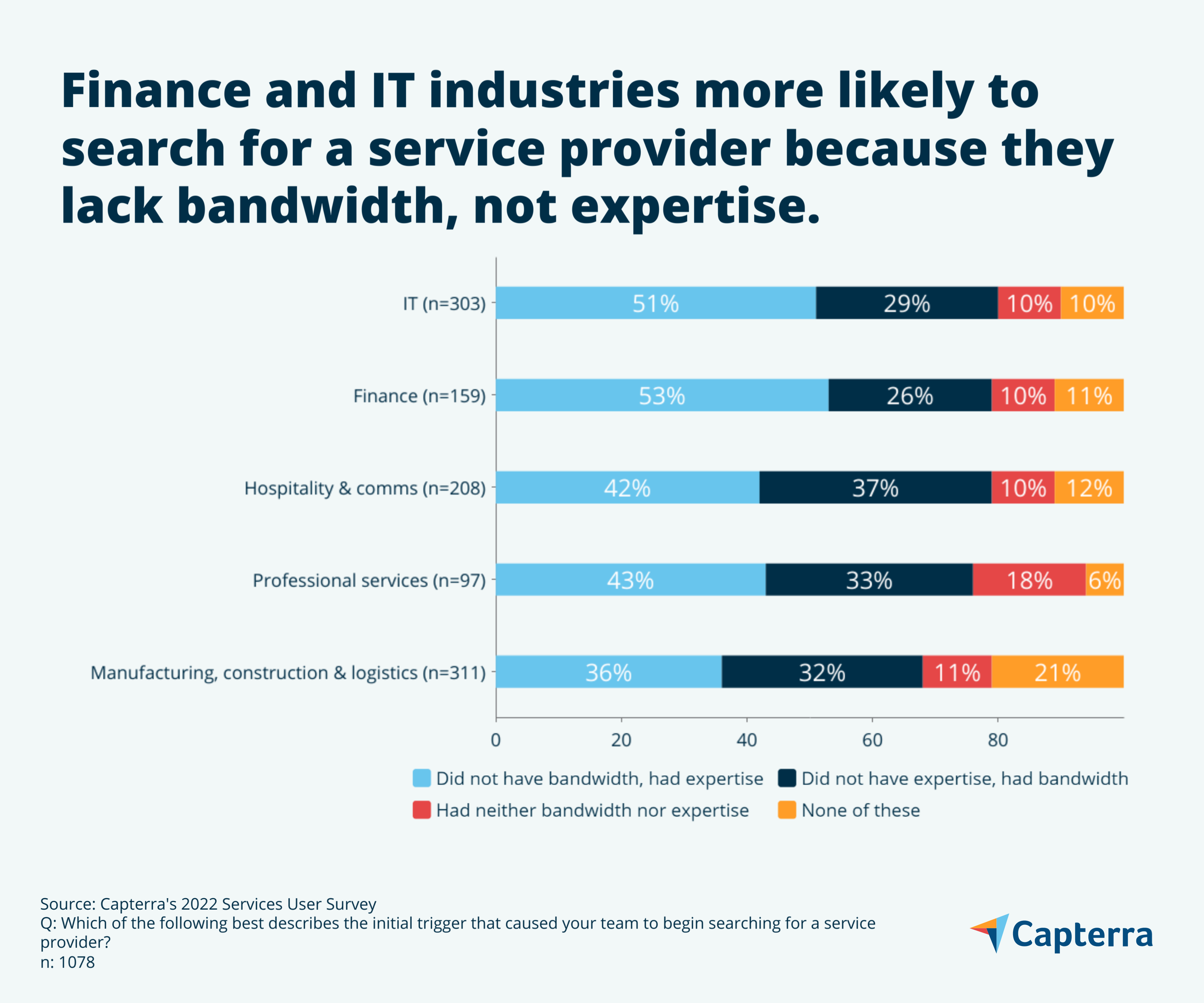
For finance industry professionals, workloads typically peak during tax season, driving the need for additional staff during this time. As for IT industry workers, additional resources may be needed at the start or development phase of a project that requires more effort.
Working with service providers allows you to receive extra help when the amount of work pushes the boundaries of what can feasibly be done at an organization, allowing you to delegate tasks to experts and maintain a desired level of productivity.
Let’s take a look at the types of services SMBs are currently purchasing.
Tech services are in demand
In recent years, digital acceleration has come to command business attention, propelling web design and development needs to new levels of demand. These types of tasks are notoriously tedious as well as time- and attention-consuming.
According to our research, nearly a third (32%) of services purchasers contracted for custom software or web development (e.g., mobile app development, user experience design, and web design/development) for their most recent engagement:
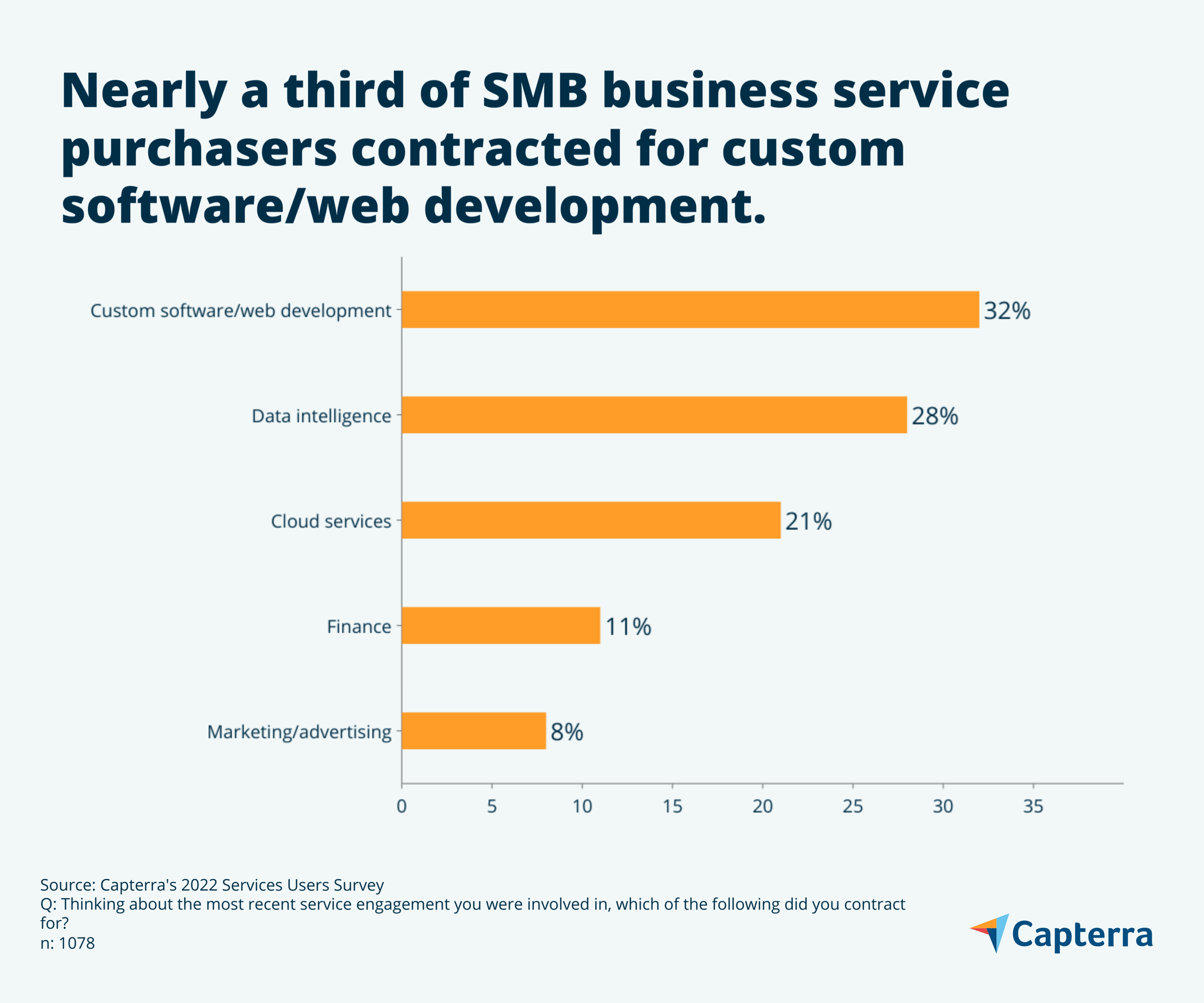
There are many options available when it comes to external service providers. But how can businesses select the right partner for their unique projects? To shed some light on this, let's explore some of the critical factors business-service purchasers find important.
Ready to hire a custom software development company for your business needs? Browse our list of companies in the following areas:
Creativity and flexibility are key considerations
SMB business-service purchasers are seeking agile providers—more than factors such as cost and geography. When researching, respondents say that partners that offer creative solutions and flexibility are the most important considerations:
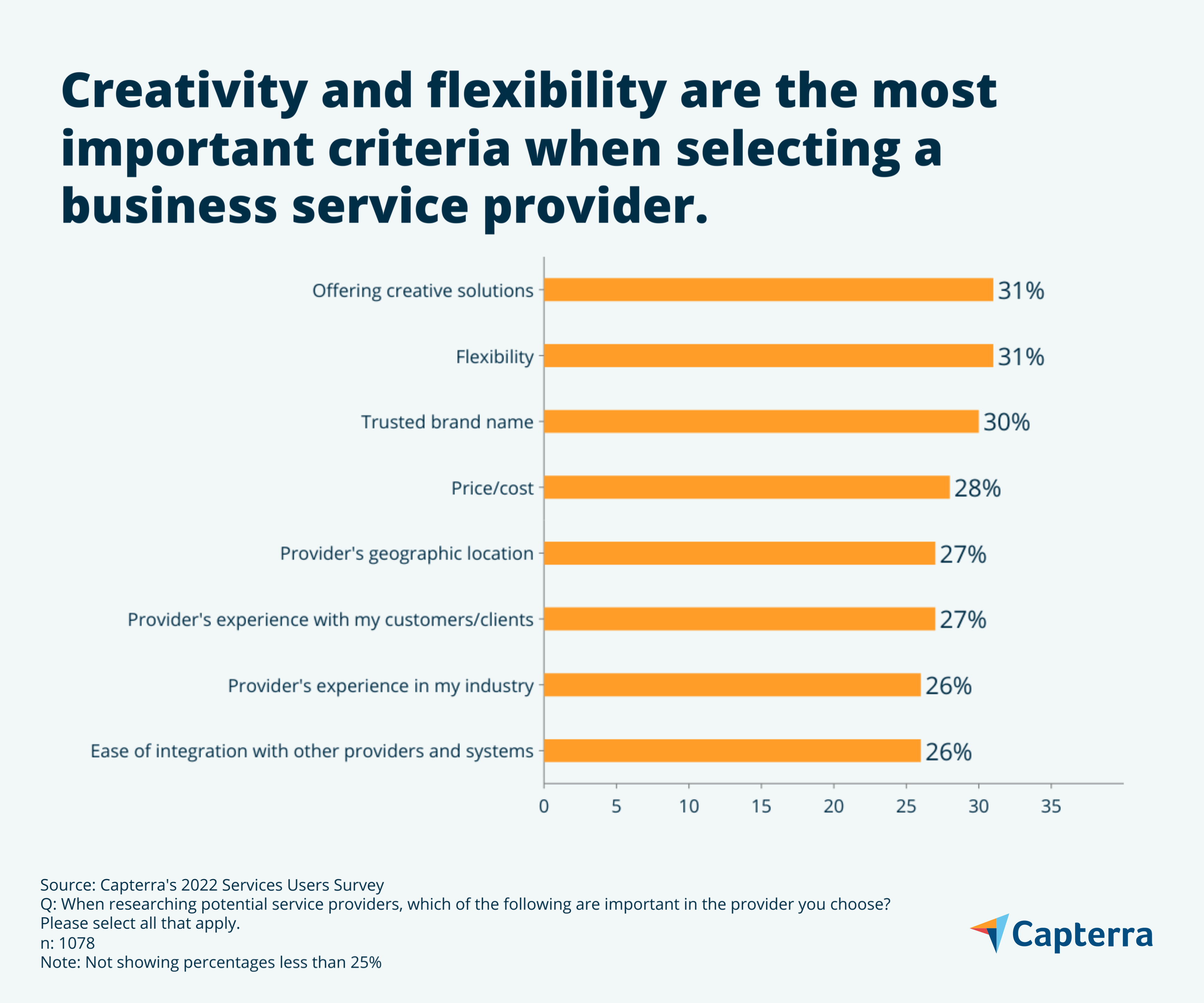
Let’s face it, working with external partners can be complicated. Maybe there isn’t always a clear vision or requirements from stakeholders, or even a detailed scope of work. Among business-service purchasers, 20% say they needed a timing extension on their most recent engagement due to changes in scope.
Partners that are flexible, creative, and solutions-focused are best suited to respond to evolving projects and look for opportunities or try new methods when change inevitably comes along. Additionally, seek out contracts that allow for adjustments if or when business priorities evolve. You need your service providers to be able to manage changes, good and bad.
It’s also best practice to have a budget at the outset of service engagement, allowing for some fluctuation over time. A majority of business service purchasers (64%) had a loose budget in mind at the start of a project but had some flexibility as the project progressed. Among those who set a budget, 17% wish they would have budgeted more on their most recent engagement:
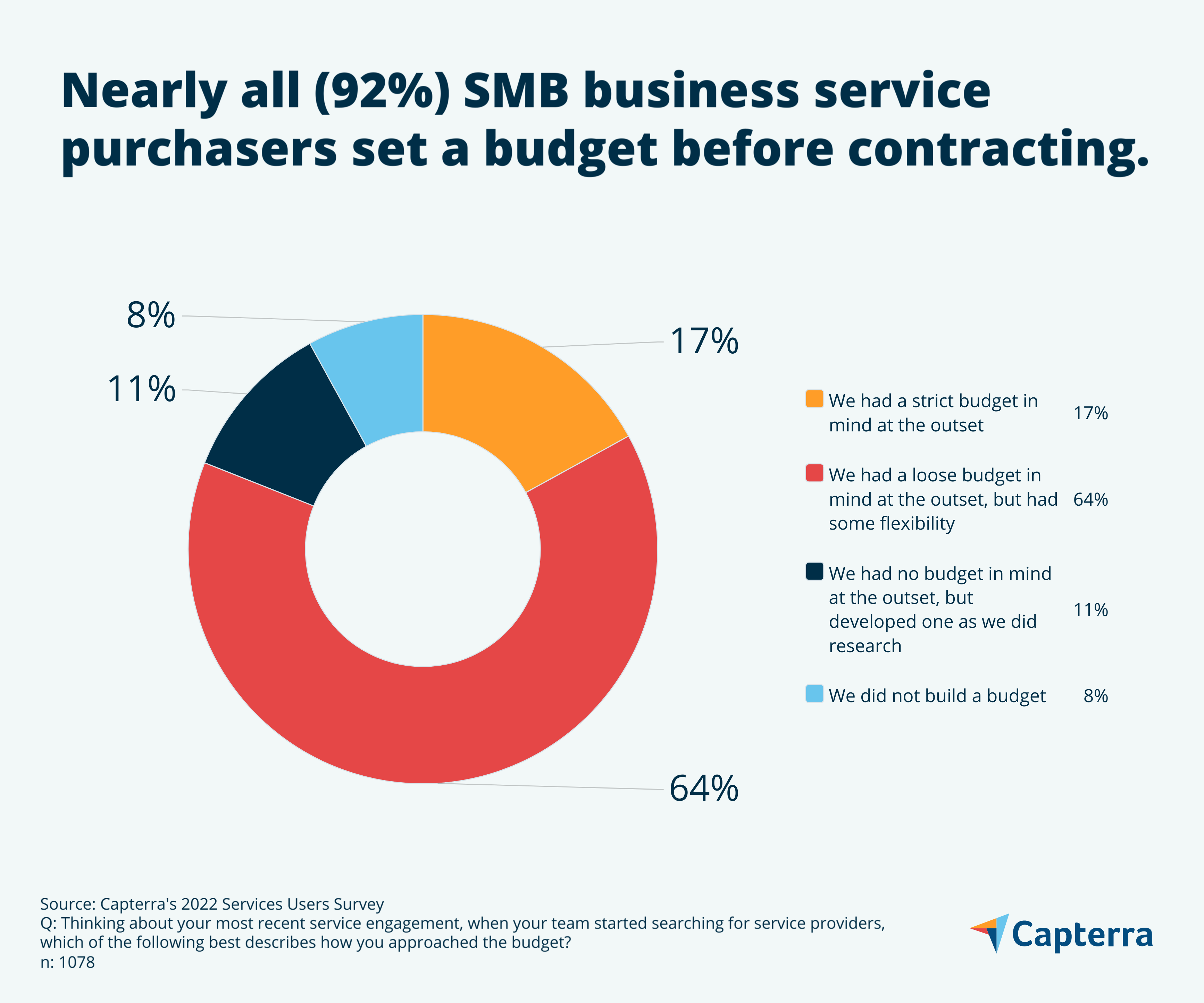
On average, SMB service purchase decisions are made in less than four months. Fifty-eight percent of purchasers say it took less than three months to make their most recent service purchase decision.
Luckily, there are many resources purchasers can use to find the right provider. A third of business service purchasers say that Google is the most important resource during the purchase process. However, many rely on sources such as social media, recommendations, comparison websites, shortlists, and more. It’s ideal to review a variety of outside sources before jumping into a contract.
Looking for business services? Check out our extensive business-service categories as a starting place.
Service purchasers spend most on marketing in the short-term, software and cloud consulting services in the long-term
Comparing prices is top of mind for many business service purchasers when considering working with strategic partners. According to our survey, service purchasers on average spent $73.8K on their most recent purchase. Those purchasing marketing and finance services spent the most:
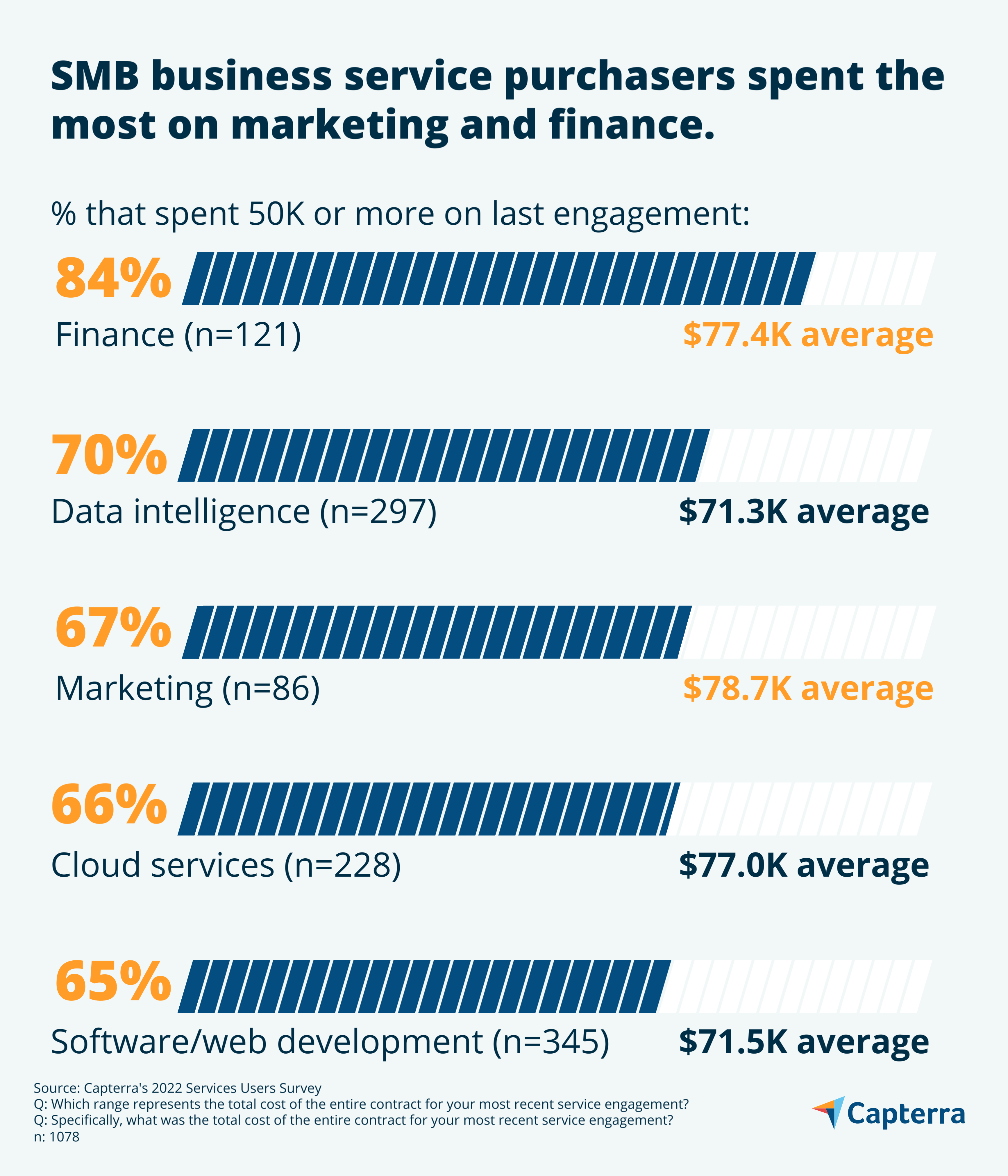
Over time (18 months), business-service purchasers investing in tech such as software/web development ($121,600) or cloud consulting services ($117,900) spent more on average compared to other types of services. Compared to total respondents from our survey, these purchasers spent between $4,000 to $8,000 more over the same timeframe.
Be sure to compare your external partner’s price against other providers. Tech service providers may use various pricing models (e.g., charge a fixed fee, hourly rate, monthly subscription, etc.). Some may also receive commissions from selling third-party technology and charge more as a result.
/ Hiring guides
If you're unsure what you should be paying for services such as cloud consulting, data intelligence, marketing, finance, and more, please check out our hiring guides that cover common service provider pricing models:
4 tips for strategic partner success
Considering bringing on an external services provider? Based on research from Capterra, here are four specific steps you can take to ensure your partnership is successful:
1. Set clear business objectives
Working with external partners is a big step, with risks involved if not planned or executed correctly. Remember, you are most familiar with the specifics of your company and the project requirements. At the beginning of every project it’s vital to ascertain your business objectives. Start by asking, why are we seeking a strategic partner? What will be accomplished? Also, be sure to engage with stakeholders early on and ensure you are focusing on the right tasks. For example, it might be a gamble to leverage external partners for tasks that directly impact customers.
2. Embrace vendors that are willing to adapt or innovate with your business
One of the benefits of working with external providers is having access to a variety of talent with different skills and being able to bring them on quickly as priorities change. Seek out partners that are familiar with your industry and type of business. You can also read user reviews to get insights into the company’s credibility and quality of work. Make sure the provider’s features and strengths line up with your objectives.
3. Set a clear budget
As noted earlier, most services projects require a substantial investment. With that in mind, make sure you choose a provider that offers the services you need within the budget you have. Many purchasers find it helpful to allow room for fluctuations if a project’s scope changes.
4. Consider all costs
Always factor in the time it takes to negotiate, draw up a contract, and execute the project when considering a service provider, as some of these costs might not be top of mind at the outset of a project. Although it depends on the size, complexity, or scope of the project or team, contract lengths will typically range from six months to a year. A majority of business-service purchasers (63%) indicate that their last engagement was only contracted for less than a year; nearly 40% contracted for six months or less.

